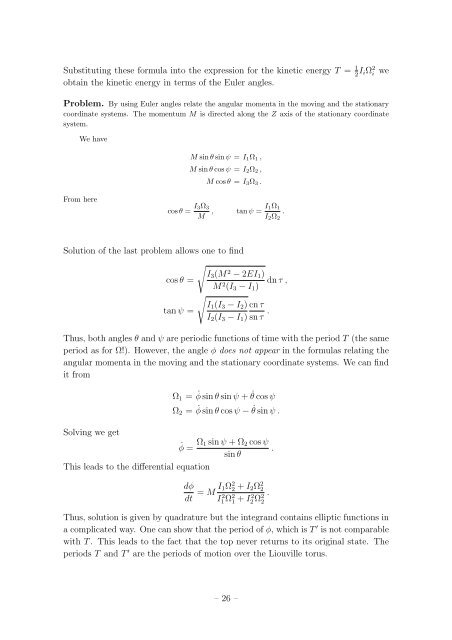Student Seminar: Classical and Quantum Integrable Systems
Student Seminar: Classical and Quantum Integrable Systems
Student Seminar: Classical and Quantum Integrable Systems
Create successful ePaper yourself
Turn your PDF publications into a flip-book with our unique Google optimized e-Paper software.
Substituting these formula into the expression for the kinetic energy T = 1I 2 iΩ 2 i<br />
obtain the kinetic energy in terms of the Euler angles.<br />
we<br />
Problem. By using Euler angles relate the angular momenta in the moving <strong>and</strong> the stationary<br />
coordinate systems. The momentum M is directed along the Z axis of the stationary coordinate<br />
system.<br />
We have<br />
M sin θ sin ψ = I 1 Ω 1 ,<br />
M sin θ cos ψ = I 2 Ω 2 ,<br />
M cos θ = I 3 Ω 3 .<br />
From here<br />
cos θ = I 3Ω 3<br />
M , tan ψ = I 1Ω 1<br />
I 2 Ω 2<br />
.<br />
Solution of the last problem allows one to find<br />
√<br />
I 3 (M<br />
cos θ =<br />
2 − 2EI 1 )<br />
dn τ ,<br />
M 2 (I 3 − I 1 )<br />
√<br />
I 1 (I 3 − I 2 ) cn τ<br />
tan ψ =<br />
I 2 (I 3 − I 1 ) sn τ .<br />
Thus, both angles θ <strong>and</strong> ψ are periodic functions of time with the period T (the same<br />
period as for Ω!). However, the angle φ does not appear in the formulas relating the<br />
angular momenta in the moving <strong>and</strong> the stationary coordinate systems. We can find<br />
it from<br />
Ω 1 = ˙φ sin θ sin ψ + ˙θ cos ψ<br />
Ω 2 = ˙φ sin θ cos ψ − ˙θ sin ψ .<br />
Solving we get<br />
˙φ = Ω 1 sin ψ + Ω 2 cos ψ<br />
.<br />
sin θ<br />
This leads to the differential equation<br />
dφ<br />
dt = M I 1Ω 2 2 + I 2 Ω 2 2<br />
.<br />
I1Ω 2 2 1 + I2Ω 2 2 2<br />
Thus, solution is given by quadrature but the integr<strong>and</strong> contains elliptic functions in<br />
a complicated way. One can show that the period of φ, which is T ′ is not comparable<br />
with T . This leads to the fact that the top never returns to its original state. The<br />
periods T <strong>and</strong> T ′ are the periods of motion over the Liouville torus.<br />
– 26 –

















